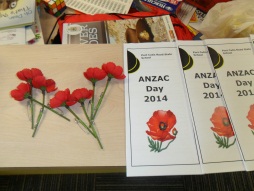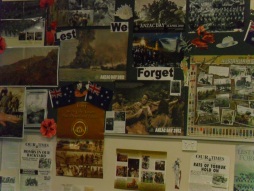Port Curtis Road State School is actively involved with many schools in our Cluster and associated schools including Ridgelands SS, Bajool SS, Depot Hill SS, Marmor SS, Stanwell SS and Westwood SS. We combine for the benefit of the students and staff to collaborate and share resources and facilities including:
Our school community also liaises with a variety of organisations and local businesses including
- Hastings Deering (Breakfast Club and events)
- Brumbys (Breakfast Club)
- Capricornia RSL Sub Branch (ANZAC and Remembrance Day)
- PlayMatters (Playgroup "Connect and Grow" and Porty Pebbles/Step into Prep)
- Local and Federal Members of Parliament
- Councillor
ANZAC and Remembrance Day
Port Curtis Road State School actively participates annually in our Remembrance day and ANZAC day school ceremonies and Rockhampton's street parade.



Anzac Day is a day to reflect and remember all
the servicemen and servicewomen who have served our country “then and
now”. At Port Curtis Road State School
we commemorate their sacrifices so that we are able to live our lives as we do
today.
2015 Anzac Day commemorated the Anzac Centenary, marking 100
years since our involvement in the First World War. The Centenary is an
opportunity to remember those courageous Queenslanders who have fought and
served in all wars, conflicts and peace operations, and especially remember the
sacrifice of all those who have given their lives in service. It is our chance
to honour the digger qualities of mateship, teamwork, resilience, courage,
integrity, duty and sacrifice that live on in the spirit of Australians to this
day.
We honour a past student of
Port Curtis Road State School with a memorial garden situated at the front of
the school. Private James Hamilton Phillips (1380A, 15th Battalion 2nd
Reinforcement) attended Port Curtis Road State School as a child with his two
sisters Alice and Charlotte.
James had been working in the
Rockhampton area as a carpenter when he enlisted. He enlisted on the 3rd December
1914 and his unit embarked from Brisbane, Queensland, on board HMAT A48 Seang
Bee on 13 February 1915. Private Phillips served in Egypt and Gallipoli.
He was killed in action on the
9th May 1915. He was 25 years of age. He has no known grave but is commemorated
at Panel 48, Lone Pine Memorial, Lone Pine Cemetery, Gallipoli. Private
Phillips was awarded the 1914-15 Star, the British War Medal, and the Victory
Medal.

2021 Remembrance Day
Port Curtis Road State School was established in 1875 and Remembrance Day is an important day in our school year. Remembrance Day is significant to each and every one of us. It is a day when we remember, honour and reflect not just the ANZAC's but all servicemen and servicewomen who have died as a result of war and peacekeeping activities.
On the 11th day of the 11th month Australians take time to remember the men and women who fought and died in wars. Originally called Armistice Day, the day when the first World War ended after four years of fighting. Close to 62,000 Australians, men and women, lost their lives during the First World War. Together with the United Kingdom, the government of Australia decided to rename Armistice Day to Remembrance Day after the end of the second World War. New Zealand, the United States, the United Kingdom and Australia all commemorate Remembrance Day.
Remembrance Day marks the anniversary of the guns falling silent on the Western Front in the First World War: the eleventh hour of the eleventh day of the eleventh month. Our nation stands in silent reflection for one minute on 11 November to reflect the importance of Honouring the Australian personnel who have died or suffered in wars, conflicts and peacekeeping operations.
2021.
This year we commemorate the 80th Anniversary of the Service in Greece and Crete. In 1941 British forces, including Australians and New Zealanders, fought to defend Greece and then Crete from German invasion. After bitter fighting in a series of rear-guard actions against a German airborne force, they were forced to evacuate and many became prisoners of war. Among the Australians fighting during the evacuation of Crete was this gun crew from HMAS Perth, who returned fire from German fighter aircraft as the ship transported troops from Sfakia.
We will remember them.
Lest we forget.
Remembrance Day traditions
A minute of silence. Every year, nations around the globe fall silent for one minute at 11am on the 11th day of the 11th month to remember those who have served their country during war.
This practice stems from King George 5th's declaration on the 6th of November 1919 that people throughout the Commonwealth should suspend their normal activities so that in “perfect stillness the thoughts of everyone may be concentrated on reverent remembrance of the Glorious Dead".
A red poppy.
The Flanders poppy was one of the first plants to grow on the blood-soaked battlefields of France and Belgium. In nineteenth century English poetry, poppies often symbolised sleep or oblivion. After World War One, silk poppies were sold on Armistice Day with proceeds going to a charity for French children and to the Returned Soldiers League.
A sprig of rosemary.
Many people wear a sprig of rosemary on Remembrance Day and on ANZAC Day. Since ancient times this aromatic herb has been recognised as a sign of remembrance and loyalty. For Australians, rosemary is even more significant as this plant grows wild on the Gallipoli peninsula, serving as another reminder of the ANZAC troops who lost their lives there. We have a Gallipoli Rosemary growing in one of our gardens.
A flag at half-mast.
On Remembrance Day, flags are flown at half-mast from 10.30am to 11.03am as a sign of mourning and respect. It is said that this tradition stems from sailing ships that lowered their sails at sea to honour an important person or to mark a death. There are a number of rules associated with flying the Australian flag at half-mast. The flag can never be flown at half-mast at night. If in a group of flags, all flags should be lowered to half-mast, however, Australia's should be lowered last and raised first.
The Ode of Remembrance.
Written just a few weeks after the war began, For the Fallen anticipated much about the war on the Western Front – not least the vast numbers of dead and the symbolism that came to be associated with the red poppies which grew in profusion in northern France and Flanders. For soldiers who fought on the Western Front, the Ode of Remembrance also called to mind two of the most important moments of the day in the trenches – dawn and dusk, the time of the 'stand-to'. This was the favoured time of attack by armies on both sides and all eyes at sunrise and sunset were focused on the enemy line. Though it was written more than a century ago, in its remembrance of the dead and its sorrowful evocation of the future they were denied, the Ode of Remembrance remains relevant to the present day.
The Ode of Remembrance.
They shall grow not old, as we that are left grow old:
Age shall not weary them, nor the years condemn.
At the going down of the sun and in the morning
We will remember them.
Lest We Forget.
Pledge of Remembrance.
Australian soldiers – hear this pledge – your flag flies in the sun
And now we take a minute to remember what you've done
When you went away to battle, you were proud as proud can be
And you did it for your country, yes, you flew the flag for me
Now we live our life with freedom when we work and when we play
For that, my heart says 'Thank you' on this very special day
And as we go, we take the words that sing Australia's song
“I am young and I am worthy, I am brave and I am strong
In the face of any challenge, I will strive to rise above
I deserve this opportunity to live, to learn, to love
I can truly make a difference; my path is up to me
And this is my commitment – be the best that I can be."
Written by Rupert McCall
2016
Today we remember past sacrifices of our brave soldiers who fought and
died serving our country. Last year we honoured a past student of Port Curtis
Road State School - Private James Hamilton Phillips. He was killed in action on
the 9th May 1915. He was 25 years of age. He has no known grave but is
commemorated at Panel 48, Lone Pine Memorial, Lone Pine Cemetery, Gallipoli.
Private Phillips was awarded the 1914-15 Star, the British War Medal, and the
Victory Medal.
This year we honour another past student of our school: 2nd Lieutenant
Albert Tiegs. We honour his bravery, courage and sacrifice with a memorial
plaque and adding it to the memorial stone. 2nd Lieutenant Albert Tiegs served
our country at Gallipoli and also in France. The Tiegs family lived on Port
Curtis Road. Albert attended Port Curtis Road State School as a student. His
parents were Albert Frederick and Caroline Johanna Tiegs. Albert was 21 years
old when he first enlisted in the 11th Battalion as a Private. He was wounded
at Gallipoli before returning to Australia due to his injuries as a sergeant. He
then re-enlisted in the 28th Battalion and was promoted to 2nd Lieutenant. He
was killed in action in France. 2nd Lieutenant Tiegs is buried in France.
The purpose of today is not, and never has been, to glorify war.
Rather to pay homage to our soldiers and those who gave their lives. In doing
so, we ensure a recognition by younger generations that peace and freedom have
always required a sacrifice in the past.
This Year we would also like to commemorate the Centenary of the
Somme.
Almost 300,000 Australians served on the Western Front in France and
Flanders, taking part in every major British offensive between 1916 and the
Armistice in 1918. More than 46,000 lost their lives, of whom some 18,000 have
no known grave. On the day of the Battle of Fromelles, these eight men of the
53rd Battalion prepared to take part in an attack that only three of them would
survive.